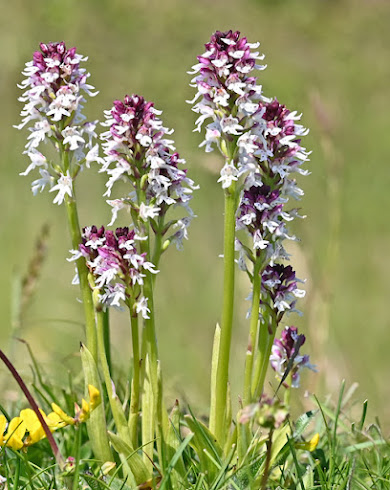On the 2nd I made the 140 mile pilgrimage to Martin Down in Hampshire, one of the best (if not the best) sites for butterflies in the UK. The sun shone throughout and I saw thirteen species, including Small Blue (lots), Grizzled and Dingy Skippers, Green Hairstreak and Marsh Fritillary. This huge area of chalk downland holds very similar species of plant, insect and birds to Therfield Heath, but none of the above are, sadly, present on my local patch! Also missing from Therfield Heath are Burnt-tip and Greater Butterfly Orchids, which were showing well here (Burnt-tip Orchids were present on The Heath many years ago, but were lost before I arrived in Royston). Whinchats and Stone Curlews nest on Martin Down, but neither species was seen on my visit. The familiar song of the Corn Bunting was heard everywhere I went, and Stonechats were also present in large numbers. Although I had the usual traffic problems on the M25, this was a very enjoyable visit.
Monday, 5 June 2023
UK Wildlife Sightings June 2023
Small Blue Butterfly, Martin Down, 2 June
Marsh Fritillary, Martin Down, 2 June
Burnt-tip Orchids, Martin Down, 2 June
On the 13th I made my first (I think) visit to Brampton Wood in Cambridgeshire, looking for Black Hairstreak butterflies, which had been reported there. By lots of scanning of Blackthorn bushes (Blackthorn is the caterpillars' food plant) I eventually managed to find some hairstreaks, but was unable to get any photos of them. This was the start of a busy ten days for me, as I made two visits to Stodmarsh NNR (Kent) on the 14th and 18th, the first to do a reconnaissance visit for a coach trip that I was leading on the 18th. Hobbies, Bearded Tits and Marsh Harriers were seen on both occasions and some of the coach party (not me!) also saw Bittern and Turtle Dove. On the first visit I had the chance to look for dragonflies and damselflies. Green-eyed (formerly Norfolk) Hawkers were everywhere and I also photographed a couple of individuals of the uncommon Variable Damselfly. The plan was to move on from Stodmarsh to visit a site for Heath Fritillary butterflies at Blean Woods. Fortunately, this species had just emerged when I visited on the 14th, and I was able to photograph a few pristine individuals. On the day of the coach trip it started to rain as we approached the butterfly site, but nevertheless everybody was able to see the butterflies - if not for long!
Male Marsh Harrier, Stodmarsh, 14 June
Variable Damselfly, Stodmarsh, 14 June
Heath Fritillary Butterfly, RSPB Blean Woods, 14 June
Always a sucker for punishment I was able to fit in a visit to RSPB Strumpshaw Fen in between the Stodmarsh trips, looking for (amongst other things) Swallowtail butterflies and Scarce Chaser dragonflies, both of which I duly found, on the 16th. A bonus here was to see and hear a male Grasshopper Warbler 'reeling'. Bee-eaters had been discovered nesting at Trimingham, about 45 minutes drive away. This was the same site where they had nested in 2022 and, since the viewing area was opened to the public for the first time on the 16th, I drove over there as well. Three birds were present, and I was able to observe them on nearby wires as well as at or near the nest site.
Bee-eater in Flight, Trimingham, 16 June
Swallowtail Butterfly, RSPB Strumpshaw Fen, 16 June
With hot, sunny weather bringing out many butterflies, dragonflies and other insects and an 'enforced' break coming up, I spent three consecutive days from the 21st to the 23rd zooming around both my local patch and further afield, looking for and photographing wildlife. On the 21st I visited the Wilstone area, looking for White-legged Damselflies along the Grand Union Canal and then popping over to the reservoir, where I saw a Hobby and possibly (since I was unable to get photographs) one or two of the rare (in the UK) Lesser Emperor dragonflies in amongst a host of Emperor dragonflies.
Immature Female Banded Demoiselle, Wilstone, 21 June
Mating White-legged Damselflies, Wilstone, 21 June
On the following day I paid my first visit of the year to the excellent RSPB Frampton Marsh reserve near Boston in Lincolnshire, with its recently-opened expanded visitor centre and cafe. The main purpose of my visit was to see Black-winged Stilts, following the recent announcements that two pairs had nested for the first time in Lincolnshire. I saw three, possibly four adults in amongst the rushes, although the young were being kept well hidden. Avocets have really taken to this reserve, with adults and young birds being seen everywhere. I also saw a couple of Spoonbills.
Black-winged Stilt, RSPB Frampton Marsh, 22 June
I was away yet again on the following day, this time walking round the reserve at RSPB Lakenheath Fen. Having missed out on Bitterns at Stodmarsh, I was hoping to see one here but the birds remained elusive on what was a surprisingly quiet late afternoon. However, many species of dragonfly were recorded, including Ruddy Darter and Scarce Chaser, which made the absence of Hobbies rather strange. I also found a Mayfly resting in the grass, which made an interesting subject for photography, even if the full inclusion of the enormously long tail spikes makes the body seem rather small.
Drake Mackerel Mayfly, RSPB Lakenheath Fen, 23 June
(Very) Mature Male Scarce Chaser, RSPB Lakenheath Fen, 23 June
Labels:
UK Wildlife
Subscribe to:
Post Comments (Atom)













No comments:
Post a Comment